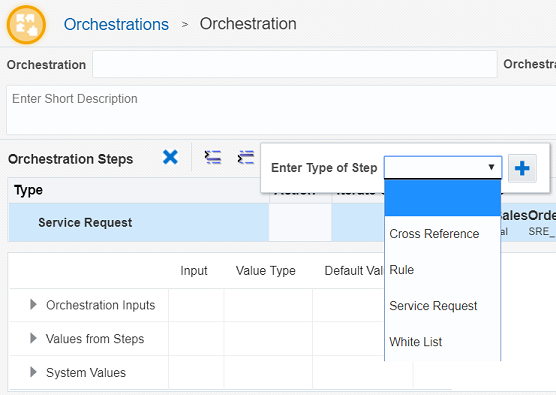Understanding the Orchestrator Studio and Orchestrations
The Orchestrator Studio is a web-based application for creating orchestrations and the components that comprise an orchestration. The JD Edwards EnterpriseOne Orchestrator processes these components when executing an orchestration instance on the AIS Server.
Use the Orchestrator Studio to create the following components:
Orchestrations. An orchestration is the master component that provides a unique name for an orchestration process. The orchestration is where you define the inputs for the orchestration, the expected incoming data. It also includes orchestration steps, which are invocations to the other components described in this list. When the Orchestrator invokes an orchestration, it processes the steps defined in the orchestration.
Service Requests. A service request contains the instructions that an orchestration uses to:
Perform a business transaction or query data in EnterpriseOne.
Send a message about a transaction to EnterpriseOne users or external users.
Retrieve Watchlist data from EnterpriseOne.
Invoke an EnterpriseOne report.
Transfer files between EnterpriseOne and another system.
Execute a custom process using custom Java or Groovy.
Invoke a REST service, database, a notification, or another orchestration.
Import data from a CSV file.
At a minimum, an orchestration defined with inputs and a service request is all that is required for the Orchestrator to process an orchestration.
Rules. A set of conditions that the input to the orchestration is evaluated against to produce a true or false state. With rules, a false outcome or true outcome can invoke further orchestration steps. You can also nest rules, in which an outcome of one rule can invoke a different rule, to produce complex evaluations. You can also use custom Java to define rules.
Cross References. A set of data relationships that map third-party values to EnterpriseOne values. For example, a device's serial number can be cross-referenced to a JD Edwards EnterpriseOne Equipment Number for use in service requests.
White Lists. A white list contains an inclusive list of values permitted in the orchestration and terminates the orchestration process if the data is not recognized.
Schedules. A schedule defines how often the system executes an orchestration or notification. You can define a schedule using minutes, hours, days, or a Cron string (for example, every Tuesday at 2:00 pm). You can attach the same schedule to multiple components.
You cannot create new notifications in the Orchestrator Studio 8. A notification is a process that can run independent of an orchestration. It enables the system to notify users of business events as they happen. The notification can contain boilerplate text and a shortcut to an EnterpriseOne application and can be configured to execute a Watchlist or an orchestration. To learn how to create notifications, see the JD Edwards EnterpriseOne Tools Notifications Guide.
The following image shows the drop-down list of the steps you can add to an orchestration. Each step in an orchestration is simply a reference to a cross reference, rule, service request, or white list component.
